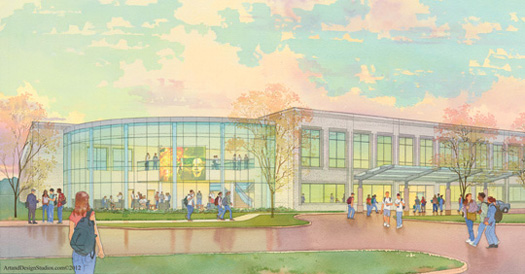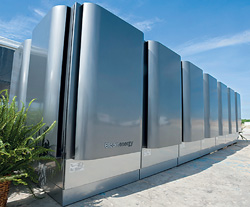Health sciences, partnerships to shine as STAR Campus takes shape

ON THE GREEN | Construction is under way for a health sciences building at the University's Science, Technology and Advanced Research (STAR) Campus—just the first phase of a long-term development plan for the site of the former Chrysler auto assembly plant.

UD, which purchased the 272-acre site in south Newark, Del., in late 2009 after Chrysler ceased manufacturing there, held a town hall meeting in May to highlight milestones and plans for the STAR Campus. Announced at the meeting was a strategic partnership with Delle Donne and Associates and Bancroft Construction Co., as well as UD's "3+1" strategy for developing the site into a campus where academics, innovation, research and partnerships will thrive.
The strategy focuses on energy and the environment, national security and defense, as well as health and life sciences plus enabling transportation infrastructure.
"We want to align our strategic priorities with opportunities," said Mark Barteau, senior vice provost for research and strategic initiatives. As a Category 1 research institution that has brought in multiple multimillion-dollar research awards, Barteau said, the University will use this "3+1" strategy to leverage its strength with location and transportation as well as academics, research and partnerships.
With the first phase of the STAR Campus development focusing on the former Chrysler administration building, which will be utilized for health and life sciences, Kathy Matt, dean of the College of Health Sciences, said she envisions this campus as a health community for a healthy community.
"In phase one, our vision is to create an innovative and comprehensive signature campus that advances how we build a strong health care workforce and create healthy communities to meet the growing state, regional and national demand for health care professionals," Matt said. "It will be an opportunity to provide health care to the community in tandem with student learning."
Ernest Delle Donne, president of Delle Donne and Associates, will be developing the former administration building, which accounts for about 15 acres. "We are here to guide the University—ensuring that we bring in the right tenants that fit into their plans and enhance the experience and opportunities for collaboration on the STAR Campus," he said.
While the STAR Campus has been a construction site for the last two years, Scott Douglass, UD's executive vice president and treasurer, explained that the University has already hosted numerous events on the campus and forged partnerships that will have a permanent home there.
"Last fall, we announced eV2g—a joint venture with NRG to build electric cars—and in April we broke ground with Bloom Energy as it will be constructing its first East Coast manufacturing facility on the STAR Campus," Douglass said.
Bloom's Energy Servers convert natural gas, biogas or liquid biofuels such as ethanol to electricity through an electro-chemical reaction, rather than combustion. Bloom's fuel cells are significantly more efficient, carbon emissions and water use are drastically reduced, and harmful air pollutants are virtually eliminated.
Development of the STAR Campus will start along South College Avenue and continue to move inward on the site, according to Andy Lubin, UD's director of real estate. The timeline for phase one anticipates opening the former administration building in January 2014.
While the health sciences complex will be constructed first, David Singleton, vice president of facilities and auxiliary services, said it could take decades for the site to be fully developed.





